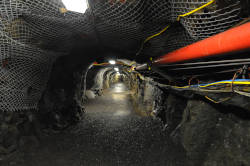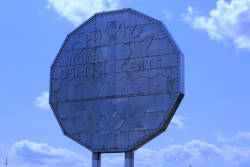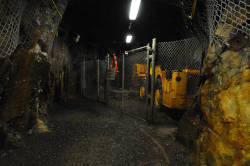Sudbury Mining Museum
Nickel Mining Museum - Dynamic Earth
Useful Information

| Location: |
122 Big Nickel Road, Sudbury, ON P3C 5T7.
(46.473832, -81.034038) |
| Open: |
All year daily 9-17. [2023] |
| Fee: |
Adults CAD 20, Children (13-17) CAD 18, Children (4-12) CAD 16, Children (0-3) free, Seniors (65+) CAD 18. With underground tour: Adults CAD 25, Children (6-16) CAD 23, Students (-26) CAD 21, Seniors (65+) CAD 23. [2023] |
| Classification: |
 Nickel Mine Nickel Mine
 Copper Mine Copper Mine
 Replica Underground Mine Replica Underground Mine
 Mining Museum Mining Museum
|
| Light: |
 Electric Light Electric Light
|
| Dimension: | T=15 °C. |
| Guided tours: |
Museum:
self guided. Mine: D=75 min. |
| Photography: | |
| Accessibility: | yes |
| Bibliography: | |
| Address: |
Dynamic Earth, 122 Big Nickel Road, Sudbury, ON P3C 5T7, Tel: +1-705-522-3701, Free: 1-800-461-4898.
E-mail: |
| As far as we know this information was accurate when it was published (see years in brackets), but may have changed since then. Please check rates and details directly with the companies in question if you need more recent info. |
|
History
| 1856 | strong magnetic abnormalities discovered by land surveyor Albert Salter. |
| 1883 | blasting at the railway construction site of the Canadian Pacific Railway revealed a large concentration of nickel and copper ore. |
| 1889 | Frank Sperry, a chemist of the Canadian Copper Company, discovers a new mineral, which was later named Sperrylite (PtAs2) after him. |
| 1964 | Big Nickel Centennial Numismatic Amusement Park opened to the public. |
| 1981 | amusement park closed. |
Geology
The Sudbury Basin is an impact crater or astrobleme, 1.849 billion years ago in the Paleoproterozoic era an impact of a meteor approximately 10–15 km in diameter created a crater 62 km long, 30 km wide and 15 km deep. It is the third-largest known impact crater on Earth, as well as one of the oldest. Debris from the impact was scattered over an area of 1.6 Million km². Rock fragments ejected by the impact called ejecta have been found as far away as Minnesota. Probably debris was scattered globally, but was destroyed by weathering since then. At least it has not been found, the theory is based on a model. The original crater was probably round and had a diameter of 130 km, but subsequent geological processes have deformed the crater into the current smaller oval shape. 1.8 billion years of weathering and deformation made it difficult to prove that a meteorite was the cause of this structure.
After the impact, the crater filled with magma containing nickel, copper, palladium, gold, the platinum group and other metals. This magma solidified forming pyrrhotite, chalcopyrite, pentlandite, cubanite and magnetite. The magnetite caused strong magnetic abnormalities which were discovered in 1856 by land surveyor Albert Salter.
Description


The Dynamic Earth is a science centre which features earth science and mining experiences. It is located at the abandoned Big Nickel Mine and was formerly known as Nickel Mining Museum. There is a background to the "Big Nickel", a replica of the Canadian commemorative coin minted in 1951 with a diameter of 10 m and 60 cm thick, is located right in front of the museum. The museum has several mining-related exhibitions, explaining minerals, geology, mining technology and ore processing. It is located in Sudbury, Ontario, due to the former nickel mine, supplier of 24% of the world’s nickel demand.
The mine is visited on guided tours, visitors get a helmet, and a sweater is also a good idea. This is actually not a former mine, it is mine replica which was started for an amusement park and later enlarged by students of mining. Nevertheless, it gives the full feeling and is actually underground, it is not a replica in a cellar or on the surface. The machinery and tools are from the abandoned mines of the area.
A highlight is the Mineral Wall, located across from the Copper Café. On this wall rocks and minerals from around the world are mounted and it is possible to actually touch them. It seems they take the term interactive quite serious.
The Big Nickel is the brainchild of a local businessman, Ted Szilva. There was a local contest to choose the city’s project to commemorate Canada’s Centennial in a nearby amusement park. He entered the idea but did not win the contest, so he decided to go ahead with the project on his own. Szilva purchased a few acres of rock overlooking Inco’s main smelter. The Big Nickel and other replica coins were constructed by Szilva’s business partner, Bruno Carvallo, a local artist and sign maker. The creation of the Big Nickel cost $35,000, which probably makes it the most valuable five cent piece in history. In 1964, the Big Nickel Centennial Numismatic Amusement Park was opened to the public. The Amusement Park thrived as the area became a tourist hub, offering lakes, fishing and other recreation, and so there lots of tourists which visited the park.
Szilva contracted miners to construct an authentic head frame and sink a vertical shaft and dig a 50 m long mine tunnel. The self-guided underground tour was becoming as much an attraction as the Big Nickel itself. During tourist season, a retired miner was usually on duty below to explain the old equipment, mining methods, and local geology. And of course tell tales of disasters and narrow escapes, or of prospectors who were more lucky than knowledgeable. Sudbury’s nickel and copper bonanza was discovered by accident by workers constructing the national railway in 1882 and nearly twenty years passed before it was exploited. The Cambrian College felt the site was ideal for training during mining courses, and over the years Cambrian students lengthened the tunnels to more than 300 m. When Szilva retired in 1981, he sold the site to the Cambrian College.
They removed the non-mining related items except the Big Nickel, as it had become an icon to Sudbury citizens. When mineral prices plummeted, unemployed miners were hired to further expand the underground works. They offered fully guided tours, and the tourists were able to see an operating mine. But they also removed the original head frame and the rattling rickety elevator. The modern elevator is not a mining elevator.
The ore deposite is actually known since 1856, when provincial land surveyor Albert Salter located magnetic abnormalities in the area. This is actually prove of a high amount of magnetite, but not of all the other ores, and it also does not mean the deposit is easy to mine. So actually nothing happened. Even after area had been examined by Alexander Murray of the Geological Survey of Canada, who confirmed the presence of an immense deposit, nothing happened. An obvious problem was the remoteness of the area, there was no infrastructure for the transport of ore or machinery. This changed with the construction of the Canadian Pacific Railway, and the construction actually revealed a large concentration of nickel and copper ore. The ore was recognized by Thomas Flanagan, a blacksmith on the CPR construction gang. The property was patented to James Loghrin, Henry Abbott and Thomas and William Murray in October 1884. It was named Murray Mine after the latter two. They actually never mined, they sold the claim to Henry Hussey Vivian and Co. of Swansea, Wales, who worked it from 1889 to 1894.
The first mine which was opened in the Basin was the Vermillion Mine. Here Frank Sperry, a chemist of the Canadian Copper Company, analyzed mineral samples. He discovered a new mineral in 1889, which was later named Sperrylite (PtAs2) after him. Numerous mines were later opened and closed, but the basin is still one of the world’s largest suppliers of nickel and copper ores.
The mining company Inco is currently renaturalising the remains of the mining. For this purpose, they have grown more than a million seedlings in played out mine shafts nearly a mile underground. The slag heaps are reforested with plenty of red pine and jack pine.
 Search DuckDuckGo for "Sudbury Mining Museum"
Search DuckDuckGo for "Sudbury Mining Museum" Google Earth Placemark
Google Earth Placemark Sudbury Basin - Wikipedia (visited: 21-MAR-2023)
Sudbury Basin - Wikipedia (visited: 21-MAR-2023) Dynamic Earth - Home of the Big Nickel (visited: 19-MAR-2023)
Dynamic Earth - Home of the Big Nickel (visited: 19-MAR-2023) Index
Index Topics
Topics Hierarchical
Hierarchical Countries
Countries Maps
Maps